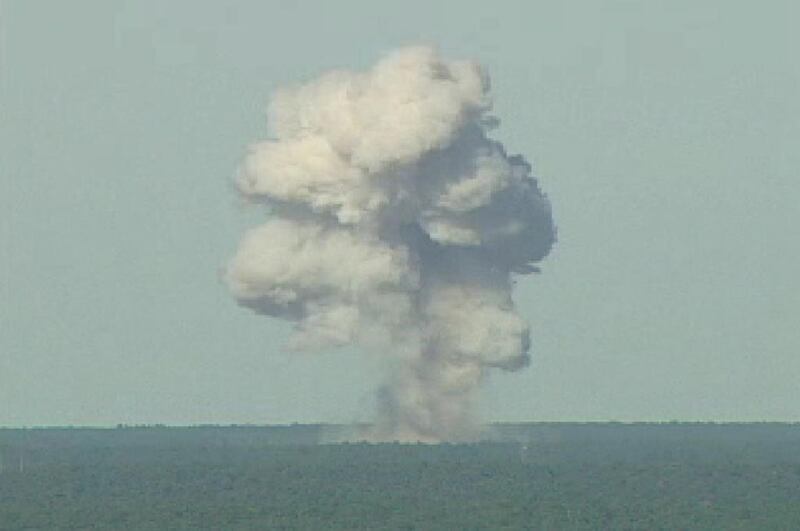US forces in Afghanistan on Thursday struck an ISIL tunnel complex in eastern Afghanistan with “the mother of all bombs”, the largest non-nuclear weapon ever used in combat by the American military.
The bomb, known officially as a GBU-43B Massive Ordnance Air Blast bomb, or Moab, unleashes almost 10 tonnes of explosives and is guided by GPS.
It was dropped at 7.32pm local time by an MC-130 aircraft stationed in Afghanistan, said Pentagon spokesman Adam Stump.
The target was a complex of caves and tunnels in Nangarhar province’s Achin district, and close to the Pakistan border, where the Afghan affiliate of ISIL has been operating.
Mr Stump said the bomb had been transported to Afghanistan “some time ago” for potential use.
White House press secretary Sean Spicer said, “We targeted a system of tunnels and caves that ISIL fighters use to move around freely, making it easier for them to target US military advisers and Afghan forces in the area. The United States takes the fight against ISIL very seriously and to defeat the group we must deny them operational space, which we did.”
Later, president Donald Trump praised the operation. “We are proud of [the US military] and this was another very, very successful mission,” he said.
Former Afghan president Hamid Karzai said on Twitter that he “vehemently and in strongest words” condemned the strike, however.
“This is not the war on terror but the inhuman and most brutal misuse of our country as testing ground for new and dangerous weapons. It is upon us, Afghans, to stop the #USA.”
The commander of US forces in Afghanistan, Gen John W Nicholson, said the strike was designed to minimise the risk to Afghan and US forces as they conduct clearing operations in the Achin area “while maximising the destruction” of ISIL fighters and facilities. The extremists have been using improvised explosive devices, bunkers and tunnels to strengthen its defences, he added.
The area where the bomb was dropped is mostly mountainous and sparsely populated but local sources said the explosion was so powerful it was heard in two neighbouring districts.
The US has not yet confirmed the results of the strike, but a local official told the BBC that many ISIL militants were killed, allegedly including the brother of a senior leader.
Afghanistan was ISIL’s first foray outside the Arab world. The extremist group established themselves there in January 2015, naming themselves Khorasan, an old name for Afghanistan, and were the first major militant group to challenge the Taliban. The US estimates ISIL has 600 to 800 fighters in Afghanistan, mostly in the eastern province of Nangarhar. The US has concentrated heavily on combating them while also supporting Afghan forces who are battling the Taliban. Just last week, an American special forces soldier, Staff Sgt Mark R De Alencar, 37, was killed in action in Nangarhar.
The Moab is the most destructive conventional (non-nuclear) bomb the American military possesses and delivers a massive blast over a huge area. It was developed at the turn of the century, at a cost of US$314 million (Dh1.15 billion) and its main purpose was psychological – to frighten the enemy into surrendering.
It is designed to destroy heavily reinforced targets or to shatter ground forces and armour across a wide area. Its blast is equivalent to 11 tonnes of TNT. By comparison, the nuclear bomb that was dropped on Hiroshima in the Second World War had 15 tonnes of explosive. But the Moab is non-nuclear so leaves no radiation effect.
The Moab was considered so controversial that the Pentagon formally examined the legality of using the bomb, and concluded that it could not be called an indiscriminate killer under the Law of Armed Conflict.
“Although the Moab weapon leaves a large footprint, it is discriminate and requires a deliberate launching toward the target,” the review said.
The lack of clarity about US foreign policy, especially since the arrival of president Trump, has left a gap which Iran and Russia have been all too ready to fill, weakening Afghanistan’s western-backed government and leaving the US increasingly on the sidelines in regional diplomacy. Washington has about 8,400 troops in Afghanistan, most of them with the Nato mission assisting Aghan forces. The rest are counterterrorism specialists working against Al Qaeda and ISIL.
In February, America’s top commander in Afghanistan, Gen Nicholson, said the aims of Russian and Iranian actions in the country were “to undermine the United States and Nato”.
On Friday, Russia is due to host high-level talks on Afghanistan with diplomats from Iran, Pakistan and China.
* With reporting from Associated Press





